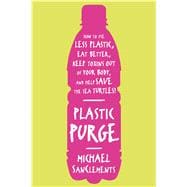Now a Denver Post #1 bestseller. Plastic is everywhere we look. Our computers and children's toys are made out of it, and our water and slices of American cheese are packaged in it. But why is there so much and what is it doing to our bodies? Is it possible to use less plastic and be happier and healthier?
In Plastic Purge, ecologist, SanClements has put together the most up-to-date and scientifically-backed information available to explain how plastics release toxins into your body and the effect they have on your and your children's health. Both approachable and engaging, Plastic Purge provides easy-to-follow advice for how to use less plastic, thereby reaping the benefits such as eating a healthier diet and living with less clutter. Dividing plastics into three separate categories: the good, the bad, and the ugly, SanClements shows you how to embrace the good (items like your phone or medical equipment), avoid the bad (food storage containers and toys that contain toxic chemicals), and use less of the ugly (single-use plastic that's just plain wasteful).
With the help of Michael SanClements's Plastic Purge, you and your family will develop easy habits to live a healthier and happier lives.









